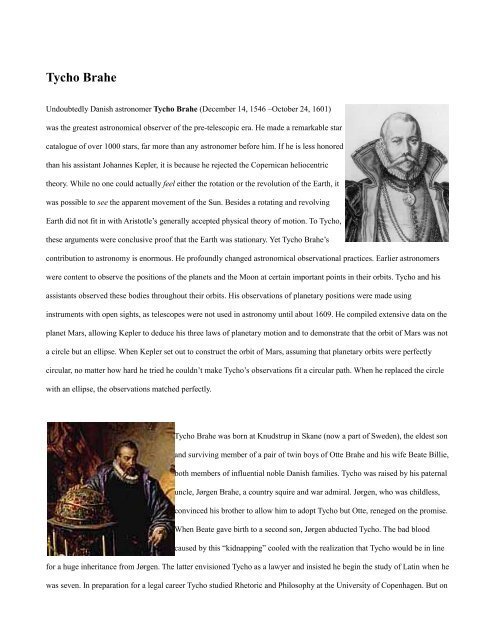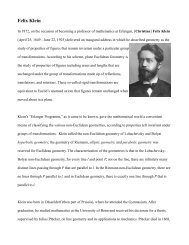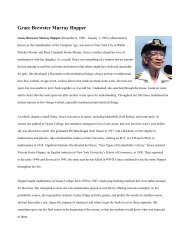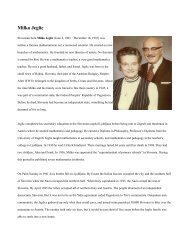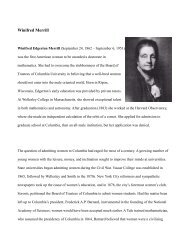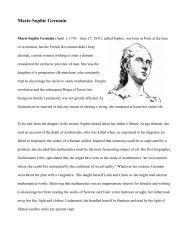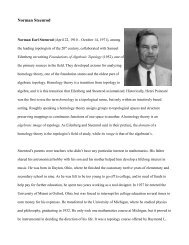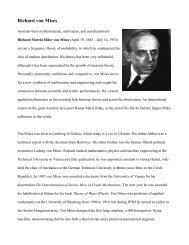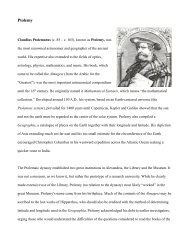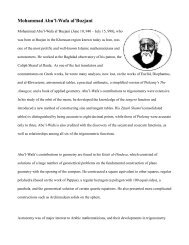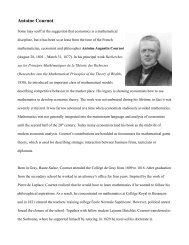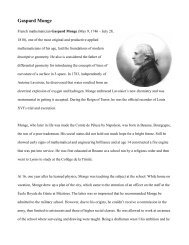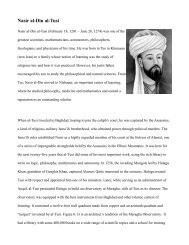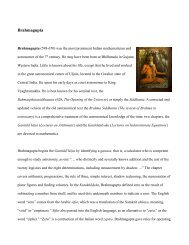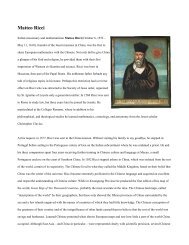Tycho Brahe
Tycho Brahe
Tycho Brahe
You also want an ePaper? Increase the reach of your titles
YUMPU automatically turns print PDFs into web optimized ePapers that Google loves.
<strong>Tycho</strong> <strong>Brahe</strong><br />
Undoubtedly Danish astronomer <strong>Tycho</strong> <strong>Brahe</strong> (December 14, 1546 –October 24, 1601)<br />
was the greatest astronomical observer of the pre-telescopic era. He made a remarkable star<br />
catalogue of over 1000 stars, far more than any astronomer before him. If he is less honored<br />
than his assistant Johannes Kepler, it is because he rejected the Copernican heliocentric<br />
theory. While no one could actually feel either the rotation or the revolution of the Earth, it<br />
was possible to see the apparent movement of the Sun. Besides a rotating and revolving<br />
Earth did not fit in with Aristotle’s generally accepted physical theory of motion. To <strong>Tycho</strong>,<br />
these arguments were conclusive proof that the Earth was stationary. Yet <strong>Tycho</strong> <strong>Brahe</strong>’s<br />
contribution to astronomy is enormous. He profoundly changed astronomical observational practices. Earlier astronomers<br />
were content to observe the positions of the planets and the Moon at certain important points in their orbits. <strong>Tycho</strong> and his<br />
assistants observed these bodies throughout their orbits. His observations of planetary positions were made using<br />
instruments with open sights, as telescopes were not used in astronomy until about 1609. He compiled extensive data on the<br />
planet Mars, allowing Kepler to deduce his three laws of planetary motion and to demonstrate that the orbit of Mars was not<br />
a circle but an ellipse. When Kepler set out to construct the orbit of Mars, assuming that planetary orbits were perfectly<br />
circular, no matter how hard he tried he couldn’t make <strong>Tycho</strong>’s observations fit a circular path. When he replaced the circle<br />
with an ellipse, the observations matched perfectly.<br />
<strong>Tycho</strong> <strong>Brahe</strong> was born at Knudstrup in Skane (now a part of Sweden), the eldest son<br />
and surviving member of a pair of twin boys of Otte <strong>Brahe</strong> and his wife Beate Billie,<br />
both members of influential noble Danish families. <strong>Tycho</strong> was raised by his paternal<br />
uncle, Jørgen <strong>Brahe</strong>, a country squire and war admiral. Jørgen, who was childless,<br />
convinced his brother to allow him to adopt <strong>Tycho</strong> but Otte, reneged on the promise.<br />
When Beate gave birth to a second son, Jørgen abducted <strong>Tycho</strong>. The bad blood<br />
caused by this “kidnapping” cooled with the realization that <strong>Tycho</strong> would be in line<br />
for a huge inheritance from Jørgen. The latter envisioned <strong>Tycho</strong> as a lawyer and insisted he begin the study of Latin when he<br />
was seven. In preparation for a legal career <strong>Tycho</strong> studied Rhetoric and Philosophy at the University of Copenhagen. But on
August 21, 1560, 14-year-old <strong>Tycho</strong> witnessed the partial solar eclipse and from that moment decided to devote his life to<br />
the study of astronomy. He was sent to Leipzig in Germany to continue his study of the law accompanied by a twenty-yearold<br />
tutor, Anders Vedel, later to become Denmark’s first great historian. <strong>Tycho</strong> had no intention of abandoning his dream.<br />
He acquired a Latin copy of Ptolemy’s Almagest, as well as sets of the Alfonsine Tables and the Copernican Tables that<br />
showed the positions of planets at any time. While officially studying the humanities, he purchased more books and<br />
instruments that he hid from Vedel, and spent each night observing the heavens.<br />
On August 17, 1563, <strong>Tycho</strong> observed Jupiter and Saturn passing very close to each other. A check of his tables showed that<br />
the Alfonsine Tables were off by a month in predicting the event and the Copernican Tables missed it by a week. He decided<br />
it would be his job to create the most accurate tables possible. He began constructing his own instruments; some of his own<br />
design, including a radie (a pair of calipers) made of wood with the degrees divided by transversals. Back home, Jørgen<br />
died of pneumonia after jumping into one of the canals of Denmark to rescue King Frederick II from drowning. Rumor has<br />
it, the king, a heavy drinker, had been drunk at the time. After a brief visit at home <strong>Tycho</strong> went to Wittenburg to study<br />
mathematics and astronomy but was forced to hastily leave the city because of the plague. He turned up at the University of<br />
Rostock, where he fought a duel with a Danish nobleman. The argument, which may have been over who was the better<br />
mathematician, cost <strong>Tycho</strong> part of his nose sliced off by a sword. He commissioned a jeweler to make him a brilliant new<br />
nose of gold and silver alloy insert, which he wore for the rest of his life. <strong>Tycho</strong> would often unsettle visitors by taking off<br />
the insert and cleaning it while at meals. The duel essentially ended <strong>Tycho</strong>’s stay at Rostock. He spent a few months at the<br />
University of Basel in 1568, but then it was back home to meet his destiny.<br />
<strong>Tycho</strong> became famous throughout Europe for his discovery of a nova (a term he coined for what is now called <strong>Tycho</strong>’s<br />
supernova) in Cassiopea in 1572. He thus became the first to record the appearance of a supernova. The star was so bright;<br />
it could be seen even in the daytime. The significance of this discovery was that it contradicted the Aristotelian and<br />
Scholastic dogma of the invariability of the heavens. The terms nova and supernova, which respectively refer to a “new”<br />
star and an extremely bright star, are misleading. These stars are not new, they are ancient and as far as brightness is<br />
concern, this is only relative to other stars. Around this time, <strong>Tycho</strong> made an observation of a lunar eclipse and found the<br />
perigee of the Sun. In 1577 he measured the parallax of a comet, enabling him to show that it was farther away than the<br />
Moon. This conflicted with accepted Aristotelian theory that held that comets were merely atmospheric phenomena taking
place in the sublunar sphere. Fearful of losing Europe’s premier astronomer, King Frederick II offered <strong>Tycho</strong> the island of<br />
Hven in Copenhagen Sound, as well as a handsome yearly stipend, to conduct astronomical researches. Three miles long,<br />
flat with white cliffs, Hven is near Hamlet’s castle of Elsinore. <strong>Tycho</strong> hired a German architect to build his Uraniborg castle,<br />
named after Urania, the Goddess of the sky. His observatory soon was the best in Europe. He maintained a staff of<br />
instrument makers whom he closely supervised, established a printing press, a paper mill, and an alchemist’s furnace in the<br />
basement of his castle as well as a second underground observatory with isolated stations to ensure reliable independent<br />
multiple astronomical measurements. <strong>Tycho</strong> trained a generation of young astronomers in the art of making astronomical<br />
observations.<br />
After twenty years, <strong>Tycho</strong> had a run in with the new king, Christian IV, who wished to cut the astronomer’s stipend. <strong>Tycho</strong><br />
closed the observatory, packed up his instruments, and set out to find a new sponsor. In 1599 he was appointed Imperial<br />
Mathematician in the court of the Holy Roman Emperor, Rudolph II at Prague. <strong>Tycho</strong> was provided with the castle Benatky<br />
for his work and when this proved unsuitable, Rudolph gave him a house in Prague. Kepler wrote <strong>Tycho</strong> asking permission<br />
to examine his planetary observations so he might perfect his theory. <strong>Tycho</strong> replied immediately: “Come, not as a stranger,<br />
but as a very welcome friend; come and share in my observations with such instruments as I have with me, and as a dearly<br />
beloved associate.” He hired Kepler as his assistant but it was not to be a harmonious collaboration because of their<br />
conflicting views about the nature of the solar system. When <strong>Tycho</strong> observed the elongated path of a bright comet, it caused<br />
him to question the two current models of the solar system. He rejected the Copernican model, offering an intermediate<br />
position between it and the Ptolemaic model. His calculations led him to conclude that if the Earth moved, the stars must be<br />
at least 700 times farther from Saturn than the latter is from the Sun. (Actually, the nearest star is more than 40 times his<br />
number from Saturn than Saturn is from the Sun). He reasoned that God would not waste that much space in His<br />
harmonious, elegant universe. His system did away with the planetary spheres and kept the Earth, with its Moon in orbit, at<br />
the center of the Universe and the Sun revolving around it. But he compromised by asserting that the other planets orbit the<br />
Sun and are pulled along around the Earth with it [Figure 10.14]. Kepler, on the other hand, was a converted and convinced<br />
Copernican. <strong>Tycho</strong> always regarded his table of planetary motions to be his life’s work and when his end was near, they<br />
were not completed. On his deathbed he entrusted the completion of them to Kepler, who dutifully accepted the charge.<br />
Kepler recorded <strong>Brahe</strong>’s last words: “May I not seem to have lived in vain.”
Hard drinking <strong>Tycho</strong> gave tremendous feasts for his guests on Hven. He would occasionally interrupt the revelry and<br />
demand that one and all listen to the musings of a dwarf named Jepp, who he believed had second sight. <strong>Tycho</strong> also kept a<br />
tame deer that died one night after stumbling down a flight of stairs from having consumed too much beer. Legend has it<br />
that <strong>Tycho</strong> died of a burst bladder caused by too much imbibing at a banquet, because he refused to violate etiquette by<br />
leaving the table before his guests. The real cause of his illness was probably due to acute prostatitis. He died eleven days<br />
later of ureamia (urine in the blood), possibly due to poisoning with heavy metals. Mercury was found in his hair shortly<br />
after his death. He is buried in the Tyn-church in Prague. On his tombstone is written: “Neither power nor wealth, only Art<br />
and Science will endure.” The castle Uraniborg and the observatory were destroyed within a few years of <strong>Tycho</strong>’s death.<br />
Surrounded by a carefully organized garden and a square wall 250 feet on a side, the Uraniborg castle [Figure 10.15] had an<br />
onion dome and an Italianate palace façade. <strong>Tycho</strong> designed a zodiacal armillary sphere, five feet in diameter, on which the<br />
positions of stars were engraved as they were measured over a 25-year period. The quadrant in his study was built into the<br />
wall. It was centered over an open window through which observations were made. Several clocks were used<br />
simultaneously to try to time the observations as precisely as possible.
Like many early astronomers, <strong>Tycho</strong> dabbled in astrology. At the time there were more professors of astrology than of either<br />
medicine or astronomy at universities. It was considered a legitimate science that played an important role in alchemy,<br />
another legitimate science. <strong>Tycho</strong> appears to have believed that heavenly bodies influenced but did not cause terrestrial<br />
events. Apparently his forays into astrology were at the behest of his patrons Frederick II and Rudolph II. <strong>Tycho</strong> once<br />
forecast the date of Suleiman the Magnificent’s death, only to discover that Suleiman was already dead. His wife was<br />
Kirstin Jørgensdatter, although they were never married in a church, because the law did not allow marriages between<br />
nobility and commoners. They had three sons and five daughters.<br />
Quotation of the Day: “Not to be seen but to be.” – <strong>Tycho</strong> <strong>Brahe</strong>’s motto


